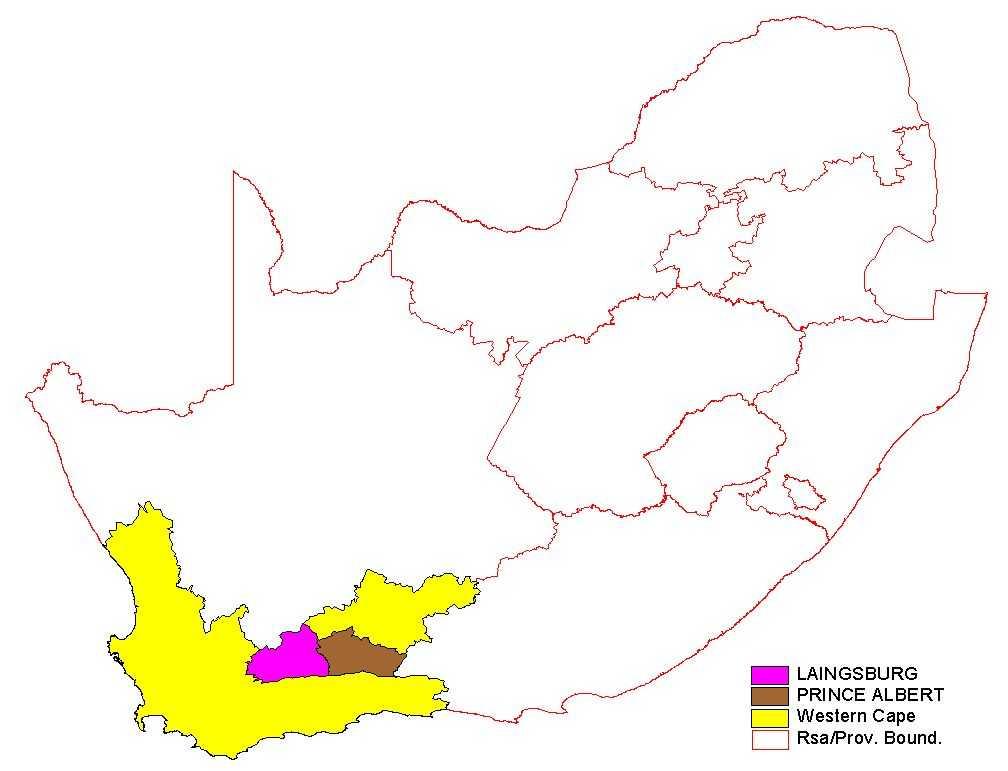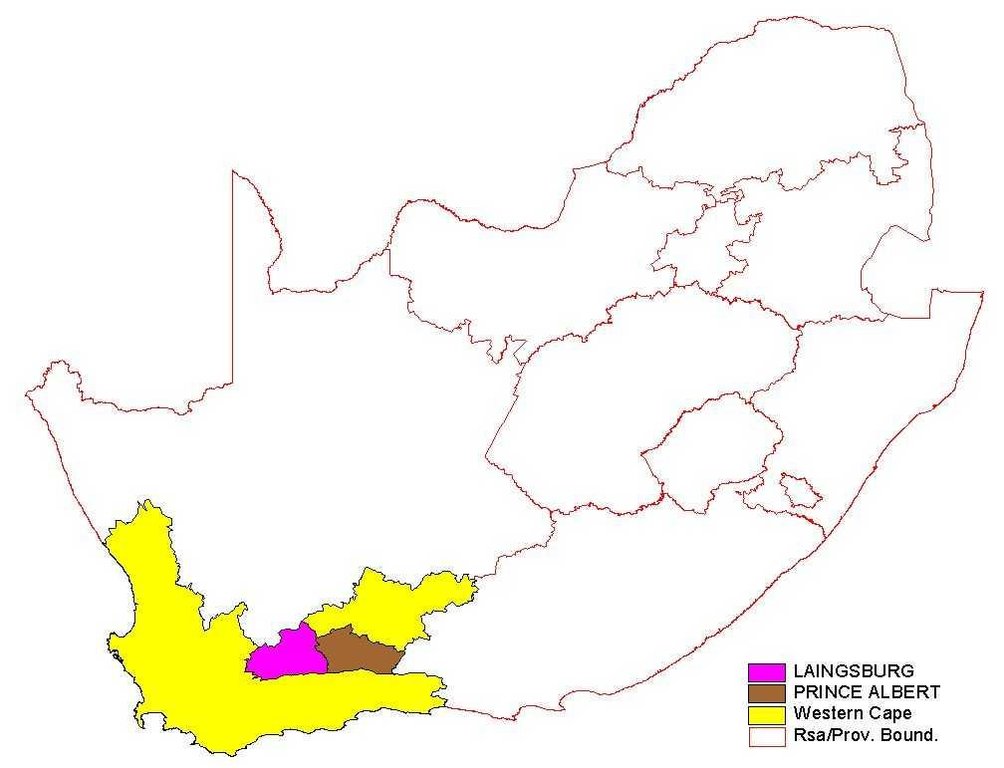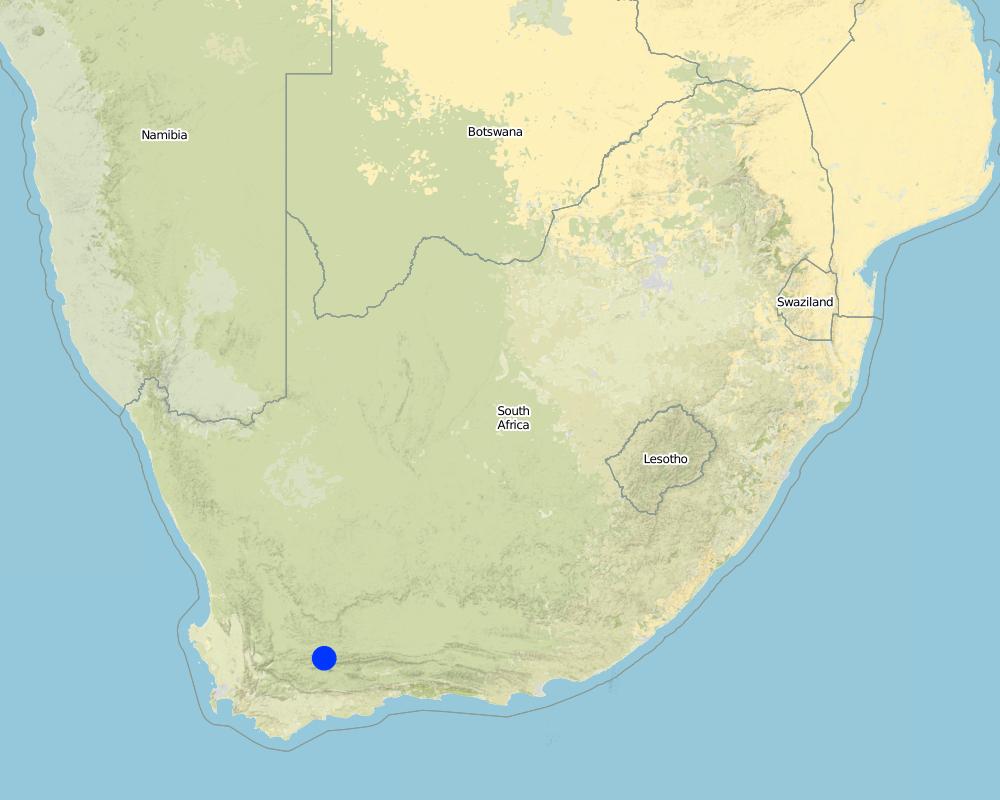Conservation Committees [南非]
- 创建:
- 更新:
- 编制者: Philippe Zahner
- 编辑者: –
- 审查者: Fabian Ottiger
approaches_2343 - 南非
查看章节
全部展开 全部收起1. 一般信息
1.2 参与方法评估和文件编制的资源人员和机构的联系方式
有助于对方法进行记录/评估的机构名称(如相关)
Swiss Agency for Development and Cooperation (DEZA / COSUDE / DDC / SDC) - 瑞士1.3 关于使用通过WOCAT记录的数据的条件
编制者和关键资源人员接受有关使用通过WOCAT记录数据的条件。:
是
2. SLM方法的描述
2.1 该方法的简要说明
The control of livestock numbers, plant management/control, and knowledge and control of plants and essential rest periods.
2.2 该方法的详细说明
该方法的详细说明:
Aims / objectives: Conservation committees. Successful commercial farmers. Research. Extension officer acts as an agent for transfer of research info
2.3 该方法的照片
2.5 采用该方法的国家/地区/地点
国家:
南非
区域/州/省:
Western Cape
Map
×2.6 该方法的开始和终止日期
注明开始年份:
1960
2.7 方法的类型
- 基于项目/方案
2.8 该方法的主要目的/目标
The Approach focused mainly on SLM with other activities (After mechanical constructions the recovery of the veld by biological processes is continued in order to get the optimal conservation condition)
Maximum use of available source for maximum profit while ecosystem is kept sound
2.9 推动或妨碍实施本办法所适用的技术的条件
社会/文化/宗教规范和价值观
- 阻碍
All grazing animals - those that produce well and those that are poor producers - eat equal amounts
Treatment through the SLM Approach: Efforts to persuade farmers to deliver the highest quality food possible with available grazing
财务资源和服务的可用性/可得性
- 阻碍
Short term production reduction which curtails farmer's financial ability
Treatment through the SLM Approach: Subsidy/reduction of livestock numbers/aid scheme during severe droughts
了解SLM,获得技术支持
- 阻碍
Livestock less important than veld for grazing
Treatment through the SLM Approach: Information and advice
3. 相关利益相关者的参与和角色
3.1 该方法涉及的利益相关者及其职责
- 当地土地使用者/当地社区
Working land users were mainly men
Conservation Committee and extension officer visited farmers owing resource poor land and urged them to a commitment to conservation.
- SLM专家/农业顾问
- 教师/学龄儿童/学生
- 国家政府(规划者、决策者)
Department of Agriculture
3.2 当地土地使用者/当地社区参与该方法的不同阶段
| 当地土地使用者/当地社区的参与 | 指定参与人员并描述活动 | |
|---|---|---|
| 启动/动机 | 无 | |
| 计划 | 无 | |
| 实施 | 无 | |
| 监测/评估 | 无 | |
| Research | 无 |
3.4 有关SLM技术选择的决策
具体说明谁有权决定选择要实施的技术:
- 主要是土地使用者,由SLM专家提供支持
解释:
land user driven (bottom-up).
Decisions on the method of implementing the SLM Technology were made by mainly by land users supported by SLM specialists. land user driven (bottom-up).
4. 技术支持、能力建设和知识管理
4.1 能力建设/培训
是否为土地使用者/其他利益相关者提供培训?:
是
明确受训人员:
- 土地使用者
- SWC specialists, extensionists/trainers, politicians/decision makers
培训形式:
- 在职
- 农民对农民
- 示范区域
- 公开会议
- 课程
涵盖的主题:
Plant knowledge, veld management, balancing of stock numbers with veld capacity in accordance with technical norms
4.2 咨询服务
土地使用者有权使用咨询服务吗?:
是
指明是否提供了咨询服务:
- 在土地使用者的土地上
说明/注释:
Name of method used for advisory service: Agricultural Conservation Committees; Key elements: Livestock reduction, Prevention and reduction of erosion, Plant management; 1) Advisory service was carried out through: projects own extension structure and agents, government's existing extension system.
Advisory service is quite adequate to ensure the continuation of land conservation activities
4.3 机构强化(组织发展)
是否通过这种方法建立或加强了机构?:
- 是,非常
具体说明机构的强化或建立程度:
- 本地
具体说明支持类型:
- 财务
- 能力建设/培训
4.4 监测和评估
监测和评估是该方法的一部分吗?:
是
注释:
There were many changes in the Approach as a result of monitoring and evaluation: Timeous adaptations as process developed
4.5 研究
研究是该方法的一部分吗?
是
明确话题:
- 社会学
- 经济/市场营销
- 生态学
- 技术
提供进一步的细节,并指出是谁做的研究:
Research was carried out both on station and on-farm
5. 融资和外部物质支持
5.1 该方法中SLM组成部分的年度预算
注释(例如主要的资助来源/主要捐助者):
Approach costs were met by the following donors: government (national): 60.0%; local community / land user(s) (-): 40.0%
5.2 为土地使用者提供财政/物质支援
土地使用者是否获得实施该技术的财政/物质支持?:
是
6. 影响分析和结论性陈述
6.1 方法的影响
该方法是否帮助土地使用者实施和维护SLM技术?:
- 否
- 是,很少
- 是,中等
- 是,支持力度很大
Reduction of livestock Establishment and conservation of seedlings in veld
Did other land users / projects adopt the Approach?
- 否
- 是,很少
- 是,中等
- 是,支持力度很大
6.3 方法活动的可持续性
土地使用者能否维持通过该方法实施的措施(无外部支持的情况下)?:
- 否
若否或不确定,请具体说明并予以注释:
Somebody with initiative will supply the required stimulation to keep the approach alive and well and to help new farmers
6.4 该方法的长处/优点
| 土地使用者眼中的长处/优势/机会 |
|---|
| As consulted with extension officer |
| 编制者或其他关键资源人员认为的长处/优势/机会 |
|---|
| Adequate livestock composition (How to sustain/ enhance this strength: Adapt as circumstances change) |
| Knowledge of veld |
| Application of veld management with due consideration of seed production and the establishment of seedlings |
| Means to stabilise serious problems concerning erosion and to effect biological recovery |
6.5 该方法的弱点/缺点以及克服它们的方法
| 土地使用者认为的弱点/缺点/风险 | 如何克服它们? |
|---|---|
| As consulted |
| 编制者或其他关键资源人员认为的弱点/缺点/风险 | 如何克服它们? |
|---|---|
| Lack of subsidy to establish infrastructure and combat severe droughts | |
| Decreased state funding of training institutions - effect on knowledge of average farmer | Sustained extension |
7. 参考和链接
7.1 方法/信息来源
- 实地考察、实地调查
- 与土地使用者的访谈
链接和模块
全部展开 全部收起链接
无链接
模块
无模块





